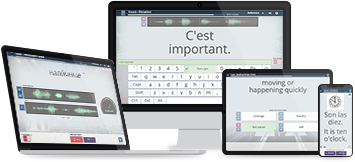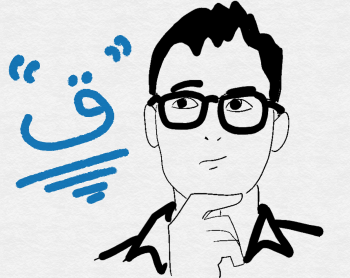Letter of the Week (ق) qaaf Posted by yasmine on Jun 24, 2020 in Uncategorized
Moving on to our twentieth letter of the Arabic alphabet (ق), we will look at various words beginning with (ق) along with more culture/language related facts.
Let’s begin with looking at your basic forms of the letter ق.
Initial ق, as in the word “قَميص” meaning “shirt”.
Medial ـق , as in the word “حَقيقة” meaning “fact”.
Final ـق, as in the word “حقوق” meaning “rights”.
To pronounce the “ق”, try making a “Q” sound in the back of your throat.
Before looking at the following words and phrases, can you think of words beginning with ق?
قَالَ: to say هَل قُلت شيئاً؟ Did you say something?
قَبْل: before/earlier هَل تَناولَت الفُطور قَبْل الذِّهاب للعَمَل؟
Did you eat breakfast before going to work?
قَتَلَ: to kill .لا أحِبُ قَتل الحَشَرات I don’t like to kill insects.
قَرَأَ: to read .أثناء الحَجر الصِّحي، قرأتُ الكَثير مِن الكُتُب
During quarantine, I read a lot of books.
قِصة: story .تبدأ قِصة حياتي في هذه المَدينة
The story of my life begins in this city
قَلْب: heart .قلبي يَنْبُض بِسرعة My heart is beating fast.
قَلَم: pen/pencil هَل يُمكِنَني استعارة قَلَم مِن فَضلك؟
Can I please borrow a pen?
☕قَهوة: coffee
How does American coffee differ from Arabic/Turkish coffee? The difference is in the method of coffee preparation. The ground beans are boiled in a special pot called إبْريق ibreeq. The coffee is boiled with sugar and sometimes cardamom هَيل hail then served in a small cup called فِنْجان finjan and allowed to sit for a few moments for the grounds to settle. It is never served with cream or milk but is always served with a thick foam رَغْوة raghweh on top. Arabs consider the more foam, the better the coffee. There are variations of Arabic coffee which are regionally based. For example, in the Gulf, cardamom, cinnamon قِرفة qirfeh and saffron زَعفران za’faran are added which makes the color of the coffee a golden yellow.
قَمَر: moon .أستطيعُ رُؤية القَمَر والنُجوم I can see the moon and the stars.
قَوي: strong/powerful
قائِد: leader/commander .إنه قائِد قوي He is a strong leader.
قُدرة: ability/capacity .لَيسَ لَدي القُدرة على مُشاهَدة أفلام الرُعب
I don’t have the ability to watch horror films.
قَديم: old/ancient .أعيشُ في مَنزِل قَديم يَحتاج إلى الكثير مِن الإصلاح
I live in an old house that needs a lot of fixing.
قَرَرَ: to decide .لا استطيعُ ان اقَرِرُ ماذا اطلُب للعشاء
I can’t decide what to order for dinner.
قَريب: close/near .أتمنى لو كان عَمَلي أقرَب إلى المَنزِل
I wish my work was closer to home.
قَصير: short .في بَعْض البُلدان، يكون الشتاء قصيراً والصَيف طويلاً
In some countries, winters are short, and summers are long.
قَليل: few/a little هل تُريد القليل مِن السُكر في الشاي؟
Would you like a little sugar in your tea?
قاموس: dictionary هل لديكَ قاموس إنجليزي – عربي؟
Do you have an English – Arabic dictionary?
قواعِد: rules/principles/grammar !اتبع القوانين Follow the rules!
القُرْآن: the holy book of Islam .يَحفظ عَشر آيات مِن القُرآن كُل يَوم
He memorizes ten versus from the Quran every day.
✨The tiny word قَدْ can have the following multiple meanings (had, has, may, might, about to, certainly, indeed)
had and has
She has/had gone to school. .قد ذهبت إلى المدرسة
about to
The game is about to begin. .قد بدأت المباراة
Certainly/indeed/surely
Let’s look at an example from the Quran: “قَدْ بَيَّنَّا لَكُمُ الْآيَاتِ إِنْ كُنْتُمْ تَعْقِلُونَ”
“We have certainly made clear to you the signs, if you will use reason.”
(Taken from Chapter (3) sūrat āl ʿim’rān (The Family of Imrān) Verse (3:118)).
may and might
She may/might go to school. .قد تذهب إلى المدرسة
Spoken Arabic
In spoken Arabic, the sound of ق is sometimes replaced with other sounds depending on dialect.
What are these other sounds?
- The first sound is the Hamza “ء” or in English, a glottal stop.
- The second sound is a “g” sound as in the English word “girl”.
- The third sound is “ك” or “k”.
For example, in Palestine, depending on which city you are in, you could hear “ق” pronounced as hamza, “ك”, or “g”.
In Jordan and Palestine, some men pronounce “ق” as “g” due to it sounding more Bedouin hence more masculine. Whereas, women pronounce it as a hamza since it’s softer to sound more feminine.
In Lebanon and Syria, most people pronounce the “ق” as a hamza.
Here is a short clip in Jordanian dialect of a man excited to drive his new car. Listen closely to hear how words with “ق” such as: قواعد، سواقة، بتلزق، بقلقني، طريق are being pronounced.
Till next time, happy Arabic learning! ?

Build vocabulary, practice pronunciation, and more with Transparent Language Online. Available anytime, anywhere, on any device.







Comments:
Fateemah:
I love it
Your method of teaching is very good and I love the experience, I am sooo happy I got to join this .
Abuauwab:
ALLAHU YUSAAIDUKUM,JUZEETUM KHAIRAA.
Bayingana omar:
Thank you ! I like how you are teaching this language. I like it (Arabic language).
Menna:
Amazing Article! You know Yasmine, I’ve just noticed after reading your article that the letter ق is one of the most unique letters when it comes to teaching Arabic! It’s the first letter of the word قرآن and the first letter of the word قراءة, it’s even the first letter of the word قصص! How amazing is that that this letter is so involved with our culture. I’ve been always fond of teaching Arabic to my little children by reading them Arabic stories. And this article gave me lots of ideas and plans of what I might be teaching next! Thanks for the amazing method of teaching Yasmine. This is one of the stories I’m teaching to my children these days to explain to them all the ways in which people are different, such as hair types, families, likes and dislikes and how we should accept others https://www.twinkl.ae/resource/-ar-a-80 and here’s a recording of me reading it https://www.facebook.com/twinklmiddleeast/videos/552452588785044 And I’ve just noticed that the letter ق is mentioned there several times!
yasmine:
@Menna Ahlan Menna!
Thank you so much for your comment; it made my day! So glad this post has given you ideas to help teach your children. I just listened to the story and enjoyed it very much. Thank you for including the link in the comments so other Arabic learners can listen to the story as well! 🙂
Best of luck in your Arabic teaching!
Salam,
Yasmine